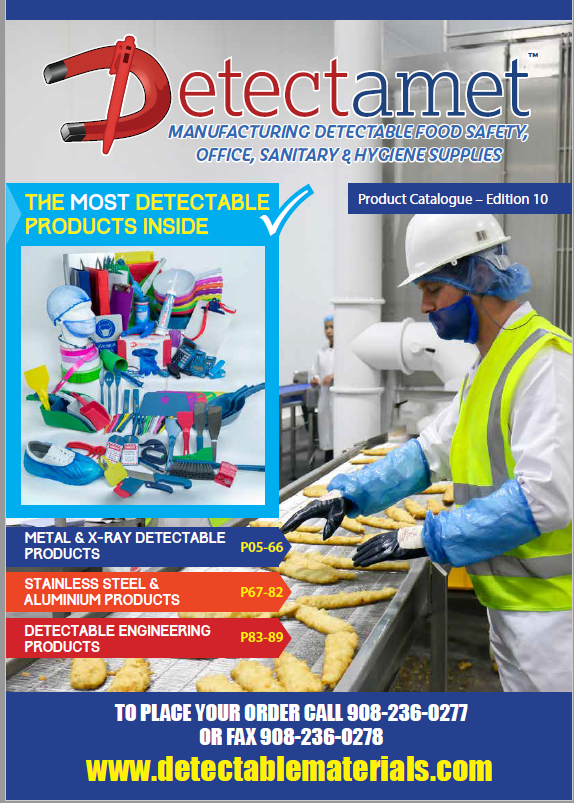Categories
Welcome to our online store!
0
item(s)
0
You have no items in your shopping cart.
0
×
Login Form
×
Registration
Profile Informations
Login Datas
or login
Industry News
MRN Web Designs Helps Detectable Materials Successfully Launch Online Store
Thanks to the key role of New Jersey-based web design company MRN Web Designs, Detectable Materials was recently able to launch its new online store. Both companies are excited for the store's success, which officially opened its digital doors on January 15. (More Info...)
Newly engineered metal and X-ray detectable plastics offer Brand Protection to Food Processors.
While much of the U.S. Food and Drug Administration’s (FDA) newly signed Food Safety Modernization Act (FSMA) remains in limbo, it is apparent that food processors and packagers will feel the burden in meeting the newly proposed standards. The new laws will effectively shift processors and packagers from a reactive contamination policy to a new strategy that stresses risk identification and the adoption of Hazard Analysis and Critical Control Points (HACCP) methods. For food processors to comply with FSMA mandates, it will require enhanced product traceability, documented maintenance and cleaning procedures, and further use of inline quality monitoring systems such as X-ray and metal detection systems.
As X-ray and metal detection systems become more prevalent, it is vital to understand the capabilities of the equipment in order to manage Critical Control Points (CCP) and ensure an effective inspection program. Merely installing detection systems is only one part of an overall Good Manufacturing Practice and will not guarantee a contaminant-free end product unless other risks are simultaneously identified.
For many years, engineered plastics have played an intricate role in maximizing efficiencies in food processing production lines. Lightweight, easily sanitized, and corrosion resistant materials such as UHMW and Acetal have been replacing metals and have become mainstays within the industry. Unfortunately, until recently, these plastic materials were not detectable by either metal or X-ray detection systems should they fragment and contaminate the food source.
As standard plastics are radio-translucent, non-conductive, and low in density, these materials cannot be detected by Metal and X-ray detection systems. Confronted with this dilemma, plastics manufacturers responded with new materials fully capable of being detected down below 2 mm depending upon the surrounding medium. While these new detectable plastic product lines intended to offer peace of mind to quality control and food safety managers, confusion has become commonplace as a flood of new detectable products have entered the market.
Understanding Detection Technologies
As the ramifications of FSMA unfold, the need for inline detection in the food industry is recognized by most equipment manufacturers and processors. Implementation of a quality control program that incorporates metal and/or X-ray inspection helps food processors to achieve compliance with HACCP and its supporting standards such as BRC, IFS, ISO 22000 and SQF 2000. An effective inspection program can also help a manufacturer conform to retailers’ QC requirements as well as national and international standard regulations.
Metal detection systems have long been incorporated into food processing facilities and have recently evolved into more advanced X-ray detection systems. Whether used independently or in conjunction with one another, it is important to fully understand the capabilities and limitations of each technology. Metal detection systems are used to detect and reject unwanted metal contamination from the end product. While metal detectors can also be used for finished product inspection, they are most effective in preventing metal contamination in bulk processing applications such as inspection of meat blocks prior to grinding or bulk grain examination. As metal detection is based upon conductivity, it is quite effective in detecting ferrous metals such as chrome and steel while less effective in finding non-ferrous metals such as copper, aluminum, and brass. Stainless steel alloys used extensively in the food industry, especially grades 304 and 316, are often the most difficult to detect due to the fact they are non-magnetic and offer poor electrical conductivity. Non-metallic contaminants such as bone, glass, and rubber are non-detectable using metal detection systems independently.
To tackle non-metallic contaminants, X-ray inspection systems offer superior detectability in food and pharmaceutical environments. In addition to detecting a wide range of contaminants including bone and glass, X-ray inspection systems can also be used to observe fill levels and measure product mass while also inspecting seals. The diversity provided by X-ray inspection systems, while a much more significant investment, is hastening the transition to this superior detection technology
. X-ray systems function primarily as a scanning device and uncover rejects based upon differentiating densities within the scanned object. Similar to the images created as you are scanned at airport security, when a package passes through an X-ray system, a grey scale image of the product is created. Pre-programmed software within the X-ray system analyses the grey scale image for abnormal density patterns that would trigger a reject--effectively removing the contaminated product from the production line.
Metal and X-Ray Detectable Plastics in Food Processing
Engineered plastics are commonplace in food production facilities as they offer a lightweight versatile alternative to metals and can also withstand corrosion commonly associated with chemical wash downs. Until recently, should plastic components fragment and enter the food source, the only means of detection was visual inspection often leaving fragments below the food surface to pass undetected.
Confronted by the stringent demands of the FSMA, food processors turned to Rochling Engineered Plastics for materials offering the desired benefits of plastics yet detectable by standard metal and X-ray inspection systems. The resulting products, Polystone M MDT/XDT (UHMW) and Sustarin C MDT/XDT Acetal, solved the detectability issue while still maintaining the dimensional stability and chemical resistance coveted in plastic components. PEEK XDT is also available for higher temperature (up to 500 degrees Fahrenheit) baking applications.
The entire family of Rochling’s detectable plastics is FDA and USDA compliant and is engineered for direct contact with food sources. All materials offer high mechanical strength, superior resistance to cleaning agents, and are easily machined for desired components. Common applications within the food industry utilizing plastic materials include kettle scraper blades, timing screws, portion/volumetric fillers, forming trays, as well as chain guides and star wheels for conveyor systems.
As your company moves to abide by the new mandates of the Food Safety Modernization Act, inspection systems will play a vital role in complying with hazard analysis and preventive control measures. The new requirements should be viewed as investments leading to the eradication of costly recalls. Upgrading the existing plastics already incorporated into your production lines to include detectability will not only further compliance, but also increase efficiencies and offer another valuable layer of brand protection.


